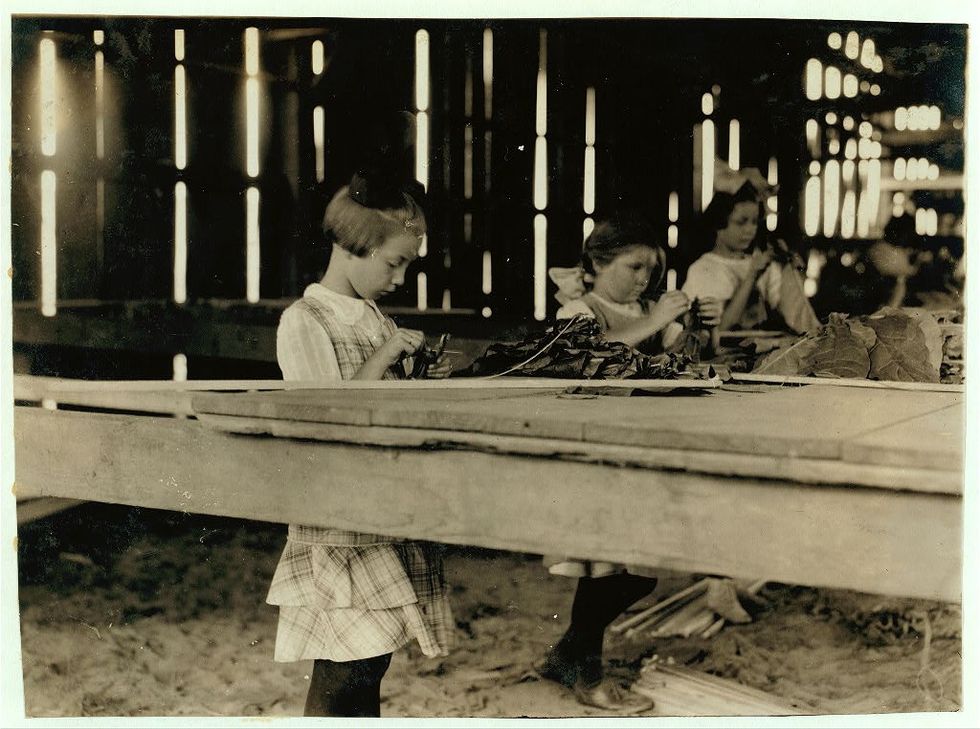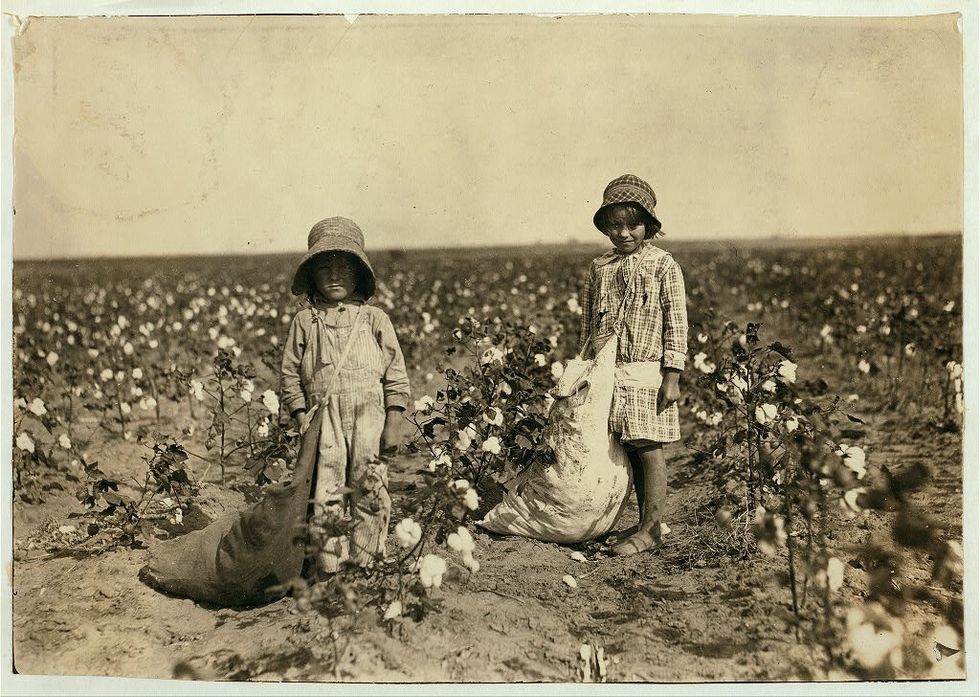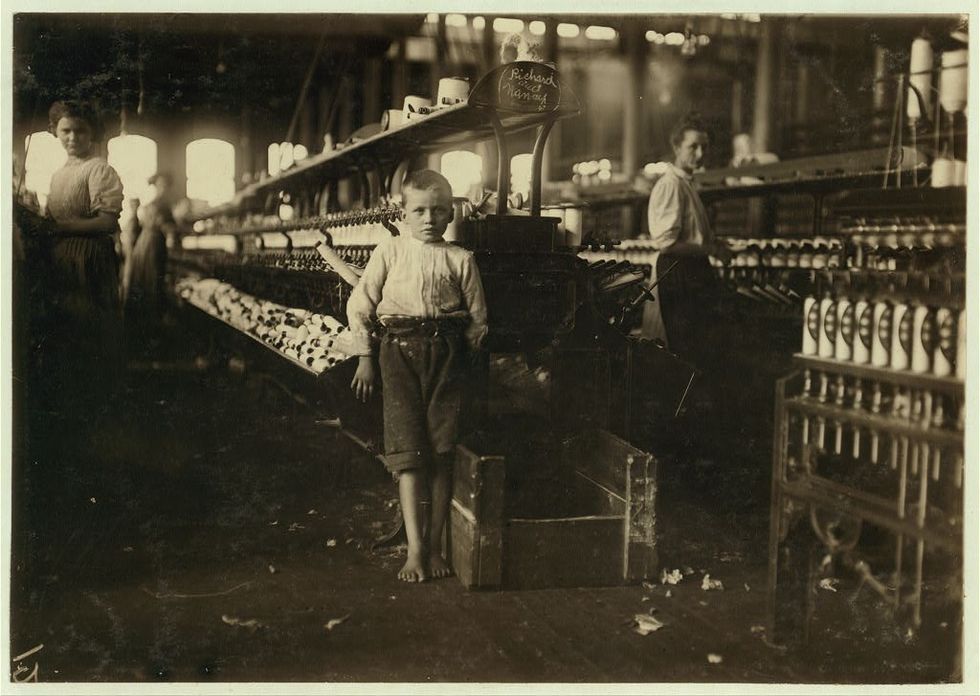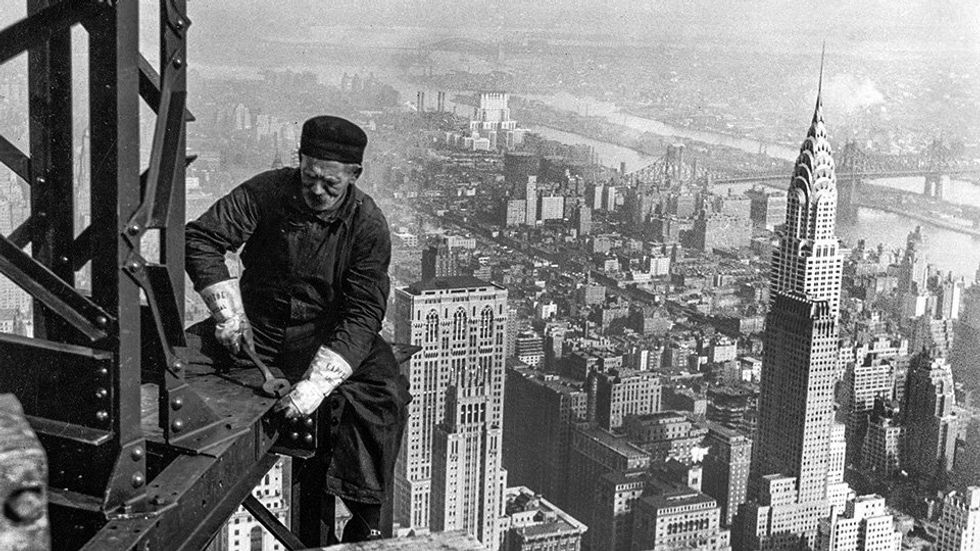

SUBSCRIBE TO OUR FREE NEWSLETTER
Daily news & progressive opinion—funded by the people, not the corporations—delivered straight to your inbox.
5
#000000
#FFFFFF
To donate by check, phone, or other method, see our More Ways to Give page.


Daily news & progressive opinion—funded by the people, not the corporations—delivered straight to your inbox.
"It's really urgent that we address our federal standards and raise them for children across the country," a co-author said.
A number of mostly Republican-controlled states have weakened child labor protections in recent years and a second Trump administration would likely escalate the deregulatory push, as per plans laid out in Project 2025, according to a report released Wednesday.
The 55-page report, Protecting Children From Dangerous Work, was prepared by Governing for Impact, the Economic Policy Institute, and Child Labor Coalition. It includes harrowing stories of teenagers killed on the job, documents right-wing plans for increased minor involvement in dangerous work, and calls for action by the U.S. Labor Department to strengthen and codify legal protections for workers under age 18.
Child labor violations in the U.S. nearly quadrupled between 2015 and 2022, according to Labor Department data.
The new report documents right-wing efforts to loosen child labor protections, particularly in the past four years, during which time lawmakers in 30 states have moved to do so. At least eight states—Florida, Idaho, Indiana, Iowa, Kentucky, Minnesota, Missouri, and West Virginia—have tried to roll back protections on child labor hours or hazardous work just since the start of 2023, the report says.
"At the time when we're seeing violations on the rise, and we're simultaneously seeing states go back on their commitment to raising standards to be above federal minimums, I think it's really urgent that we address our federal standards and raise them for children across the country who may be working in hazardous environments or in an environment that is not appropriate for someone of their age," Nina Mast, an analyst at the Economic Policy Institute and a co-author of the report, toldThe Guardian.
The policy agenda of Project 2025, a 920-page manifesto which many observers consider a blueprint for a second Trump administration, includes explicit mention of child labor issues. Many of the authors worked for Republican presidential nominee Donald Trump during his first administration.
The chapter on the Labor Department, written by Jonathan Berry, who himself worked in the department under Trump, says that "some young adults show an interest in inherently dangerous jobs" and that "with parental consent and proper training, certain young adults should be allowed to learn and work in more dangerous occupations."
The right-wing push to deregulate child labor has led several states to adopt laws that are below federal standards established by the Fair Labor Standards Act, leading to confusion for employers and employees, the new report says.
Agriculture is a sector where child labor is particularly common and is subject to its own regulations. The Obama administration tried to push through legal protections for minors in the sector in 2012 but met with major resistance from industry groups.
Still, even without further action from Congress, the Labor Department has the authority to strengthen protections for minors in agriculture and other sectors, the report authors argue. In the 2000s, the National Institute for Occupational Safety and Health issued a series of recommendations on child labor, some of which the department didn't implement—but still could, they wrote.
A detailed investigation by The New York Times last year showed that much of the exploitation of child labor, both in farms and factories, is targeted at migrants.
The new report cites a particularly awful example of the dangers of such exploitation. In July 2023, Duvan Thomas Pérez, a 16-year-old, was working as a cleaner at a chicken processing plant in Mississippi—as he did on nights after school—when a moving component of a machine drew him in and killed him. He was employed in violation of current law, the report says, pointing to the need for better enforcement of the rules already on the books.
The influential photographer—born 150 years ago this week—sought to present his subjects as people with pride and dignity, often tough and defiant, who held out hope for a better world.
The sky had not yet begun to brighten on a chilly February morning in 1911 when the first workers arrived at the seafood cannery in Biloxi, Mississippi. Slipping in after them was a slender man carrying cumbersome camera equipment. Photographer Lewis Hine was not allowed in the cannery. But he had no qualms about sneaking in at five in the morning, as he knew the managers would not arrive until hours later. He would return again at noon in a rowboat, tying up to the cannery dock, to get within striking distance of his subjects.
One was Manuel, who, at just five years old, was already a veteran shrimp picker. In the photograph taken by Hine, Manuel is round-cheeked and round-tummied, with a serious expression. Barefoot, he stands facing the camera, dressed in a checkered shirt, short pants, and a soiled apron, wearing a fisherman’s cap on his head. In each hand he holds a strainer pot. Behind him is an immense mound of oyster shells.
Hine had traveled to Biloxi on behalf of the National Child Labor Committee, a group formed in 1904. One of the greatest documentary photographers, Hine journeyed to factories, mills, fields, and mines to document how America’s children toiled. His images played a major role in the enactment of child labor laws in the United States.
Hine—who was born 150 years ago, on September 26, 1874—pioneered the use of photography as part of crusades for social reform. Now is a good time to recall Hine’s efforts as part of the broader movement to improve the conditions of children at work, in school, and in housing. In the past few years, America’s business lobby has sort to reverse that progress and roll back protections, according to the Economic Policy institute. This year alone, six states—Alabama, Florida, Indiana, Iowa, Kentucky, and West Virginia, enacted legislation to weaken child labor protections, despite an increase in child labor violations. These and other states have been trying to roll back rules that deal with youth work permits, work hours and rest breaks, and protections from hazardous work in response to lobbying campaigns by the restaurant, construction, hospitality, grocery, and farm industries. Other states, however, are pushing to strengthen laws.

Lewis Hine was born in Oshkosh, Wisconsin, above a popular Main Street restaurant that his parents owned. His father died when Lewis was seventeen years old. He worked as a hauler at a furniture factory, toiling thirteen hours a day, six days a week, to help support his mother and sister. But in 1893, during an economic downturn, the factory closed. He picked up odd jobs, splitting firewood and making deliveries. (Delivery boys were later a favorite subject in his work.) When he was hired as a bank janitor, he studied stenography at night and was promoted to secretary.
Hine’s life began to change when he met Frank Manny, who became his mentor, introducing him to the ideas of John Dewey and, later, Felix Adler, the founder of the Ethical Culture movement. Hine enrolled at the teachers’ college in Oshkosh, where Manny taught, and then spent a year at the University of Chicago. When Manny became superintendent of the Ethical Culture School in New York City, he offered Hine a job teaching geography and natural history. While teaching, Hine completed his degree in education at New York University.
The Ethical Culture School, founded by Adler, was progressive and experimental. It based its curriculum on humanist values that helped lay the groundwork for Hine’s future work. Although Hine had never picked up a camera before, Manny suggested he become the school photographer. He took pictures of school activities, set up a dark room, and started a camera club.
Manny used Hine’s emerging photography skills to teach students about social conditions, in particular the conditions facing the waves of immigrants coming through Ellis Island. Manny urged Hine to portray the dignity and worth of the newcomers, in part to help counter a growing anti-immigrant sentiment. Hine, with Manny as his assistant, lugged his rudimentary photography equipment to Ellis Island. He never photographed people without their permission, and in the cacophony of languages, he had to pantomime his requests to take a picture. Using an old box camera, glass-plate negatives, and magnesium flash powder that he had to ignite manually, he managed to capture beautiful images of people just arriving from Europe. He returned to Ellis Island many times over the coming years, taking 200 photographs in all.
After graduating from New York University, Hine began graduate studies in sociology at Columbia University. This prepared him for an assignment with Arthur and Paul Kellogg, who ran the reform-oriented magazine Charities and The Commons (later renamed Survey). They asked Hine to take pictures for the Pittsburgh Survey, a pioneering six-volume sociological study of conditions in that urban industrial city funded by the Russell Sage Foundation.
Hine followed in the footsteps of documentary photographer Jacob Riis, who captured the squalid conditions of New York’s tenements in his 1890 masterpiece How the Other Half Lives. But whereas Riis photographed his subjects as helpless victims, beaten down by an oppressive system, Hine sought to present his subjects as people with pride and dignity, often tough and defiant, who held out hope for a better world. Hine was known for inviting his subjects to reveal what they wished of themselves rather than trying to catch them or coax them into wearing expressions of anguish or emptiness. Historian Robert Westbrook credits Hine with engaging his subjects with “decorum and tact,” rarely taking candid shots but instead encouraging eye contact with the camera lens.

Hine worked with advocacy organizations that were trying to ban child labor. One of his pictures is of a mother and her four children sitting around the kitchen table, in a New York tenement lit by an oil lamp, all making paper flowers. “Angelica is three years old,” he noted. “She pulls apart the petals, inserts the center, and glues it to the stem, making 540 flowers a day for five cents.”
In 1908 the National Child Labor Committee (NCLC)—led by prominent reformers like Jane Addams, Lillian Wald, and Florence Kelley—offered Hine a full-time job as an investigative photographer. He traveled around the country, photographing doffer boys in cotton mills, cigar makers, coal breakers, cannery workers, berry and tobacco pickers, laundry workers, even glassworkers—all under the age of sixteen. To gain access to factories and mills, he would pose as a fire inspector, a Bible salesman, or an industrial photographer. When that failed, he would linger at plant gates, asking children if he could take their picture. His years of teaching, combined with a gentle demeanor, allowed him to connect well with youngsters.
In a speech to the National Conference of Charities and Correction in 1909 entitled “Social Photography: How the Camera May Help in the Social Uplift,” Hine argued that “the great social peril is darkness and ignorance.” Social reformers, he said, need to expose the terrible living and working conditions that are invisible to many Americans. “The average person believes implicitly that the photograph cannot falsify. Of course, you and I know that this unbounded faith in the integrity of the photograph is often rudely shaken, for, while photographs may not lie, liars may photograph.”
Hine was a stickler for individual details, recording whenever possible children’s names, ages, working hours, and wages. He was particularly moved by the young boys laboring at coal mines. Of their work, he wrote, “It’s like sitting in a coal bin all day long, except that the coal is always moving and clattering and cuts their fingers. Sometimes the boys wear lamps in their caps to help them see through the thick dust. They bend over the chutes until their backs ache, and they get tired and sick because they have to breathe coal dust instead of good, pure air.” While he was at a Pennsylvania mine, two boys fell in the chute and were smothered to death.

Hine’s photographs made visible the long-ignored plight of working children. They were used in brochures and booklets, news and magazine articles, exhibits and public lectures. His work played an important role in the movement to enact state and federal child labor laws (which were often paired with compulsory education laws to keep children in school), In 1912, the movement persuaded Congress to create the federal Children’s Bureau. President William Howard Taft appointed Julia Lathrop, a well-known activist who was part of the Hull House settlement in Chicago, as its first director. Over the next decade, Lathrop – the first women to head a federal agency -- directed research into child labor, infant mortality, maternal mortality, juvenile delinquency, and mothers' pensions. Using the bureau’s research findings and Hine’s photographs, the NCLC pushed Congress to pass further legislation, including the Keating-Owen Child Labor Act of 1916 and the Sheppard-Towner Act, a 1921 law that gave the Children’s Bureau the authority to conduct research and pay for services to combat maternal and infant mortality. The movement to end child labor abuses culminated in 1938 with the Fair Labor Standards Act, which included strong protections for children.
In 1918 Hine left the NCLC and went to work for the American Red Cross, traveling to Europe to document the lives of refugees who were uprooted during World War I.
During the 1920s, wanting to focus on more-uplifting subjects, he began a series of portraits honoring American workers. His final major project was to document the construction of the Empire State Building. Although by then in his mid-fifties, he scrambled to dizzying heights to photograph work that he felt captured the uplifting nature of the human spirit. These photos were published in his 1932 book, Men at Work.

In 1936 Hine was appointed head photographer for the National Research Project of the New Deal’s Works Progress Administration. But the next year, when the Farm Security Administration hired photographers to document the working and living conditions of poor and working-class Americans, Hine was not among those hired. The project director, Roy Stryker, said that Hine was difficult to work with. In addition, Hine’s approach of allowing his subjects to pose for the camera may not have been in sync with the other photographers’ notions of documentary social realism.
Hine’s life ended in misfortune. Viewed as outmoded in a time when candid shots were in vogue, he could not find work. He lost his home and ended up on welfare, dying in poverty within a year of his wife’s death. Only after his death was his work once again appreciated. Along with Riis, he is recognized as the father of documentary social photography, an inspiration to many younger photographers—including Paul Strand and others who joined the radical Photo League, as well as Dorothea Lange, Walker Evans, Margaret Bourke-White, Gordon Parks, and Milton Rogovin, who all used the camera as a weapon in the struggle for social reform. Today thousands of Hine’s images have been preserved at major institutions, including the Library of Congress.
"This bill will help level the playing field and, once again, restore the balance of power between workers and their employers," said Rep. Bobby Scott.
A group of Democratic U.S. House members on Friday unveiled legislation "aimed at bolstering protections for America's workers and ensuring accountability for employers who flout labor and employment laws."
The Labor Enforcement to Securely (LET'S) Protect Workers Act was introduced by Rep. Bobby Scott (D-Va.)—the ranking member of the House Committee on Education and the Workforce—and House Labor Caucus Co-Chairs Mark Pocan (D-Wis.), Debbie Dingell (D-Mich.), Donald Norcross (D-N.J.), and Steven Horsford (D-Nev.).
The bill's sponsors said their legislation is based on the premise that "employment laws are a promise to our nation's workers" meant to "secure the most basic rights of work."
"That promise is broken," they contended. "Recent shocking revelations about massive increases in the number of children illegally overworked and trafficked into dangerous jobs—just over 85 years since the passage of the Fair Labor Standards Act, which was enacted to eliminate that very problem—is the latest example of the ways that this promise to America's workers is broken."
Across the U.S., Republican state lawmakers have been advancing legislation to remove restrictions on child labor, despite several high-profile workplace deaths of minors. At the federal level, Sen. James Risch (R-Idaho) and Rep. Jared Golden (D-Maine) last year introduced a bill that would allow 16- and 17-year-olds to work in the logging industry.
The LET'S Protect Workers Act sponsors highlighted rampant wage theft and overtime violations, workplace injuries, and union-busting by employers who "know that even if a resource-starved Department of Labor catches a violation, the penalties are a mere slap on the wrist."
"People should be able to come home at the end of the day—alive, well, in one piece, and with all the wages they worked hard to earn," the lawmakers asserted. "Children should be in schools, not dangerous workplaces, and workers should be able to organize a union without interference or the threat of retaliation from their employers."
According to House Education and Workforce Committee Democrats, if passed, the LET'S Protect Workers Act would:
"Every American should be fairly compensated and be able to return home safely at the end of the day," Scott said in a statement Friday. "Unfortunately, shortcomings in our labor laws enable unethical employers to exploit workers, endanger children, and suppress the right to organize—with little accountability."
"That's why I'm proud to introduce the LET'S Protect Workers Act, which will hold bad actors accountable and strengthen penalties for labor law violations," he added. "This bill will help level the playing field and, once again, restore the balance of power between workers and their employers."
In a joint statement, Dingell, Horsford, Norcross, and Pocan said that "the lack of meaningful enforcement makes it all too easy for bad faith actors to get away with illegally violating workers' rights—from firing workers for organizing a union, to allowing children to work overnight shifts, or jeopardizing workers' safety by ignoring workplace regulations."
"We're proud to join Ranking Member Scott in introducing this bill to crack down on unscrupulous employers and to ensure that workers receive the protections they deserve," the lawmakers added.
Earlier this month, nearly 50 labor organizations led by the AFL-CIO and representing a wide range of U.S. workers urged congressional Democrats to resist Republican efforts to roll back rules enacted by the Biden administration to protect worker rights amid relentless attacks by abusive employers.
Specifically, the labor groups warned that Republicans are trying to use the Congressional Review Act—which was enacted to strengthen oversight of federal rulemaking—to overturn pro-worker rules enacted by the Department of Labor and other government bodies.
Meanwhile, Republicans including former President Donald Trump—the 2024 GOP nominee—have been trying to woo U.S. workers with proposals including a tax exemption for tipped employees panned as a "
hollow promise" by experts and by inviting Teamsters president Sean O'Brien to speak at the Republican National Convention last week.
In response to Republicans' dubious courting of U.S. labor, Rep. Greg Casar (D-Texas)—who is a co-sponsor of the LET'S Protect Workers Act—recently called for holding what would be a largely symbolic vote on the PRO Act. The bill was revived last year by Scott and Sen. Bernie Sanders (I-Vt.) and, if passed, would expand labor protections including the right to organize and collectively bargain.
"If Republicans wanna talk like they're pro-worker, then let's have a vote on the PRO Act next week," Casar
said on social media last week. "Let's see which politicians are for unions and which ones are all talk. Dems are ready to vote, how about you guys?"